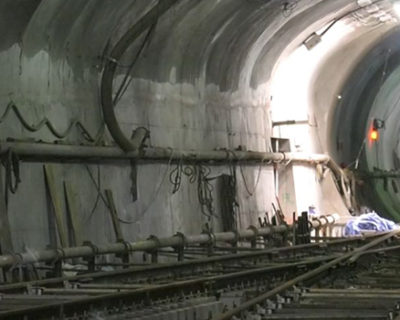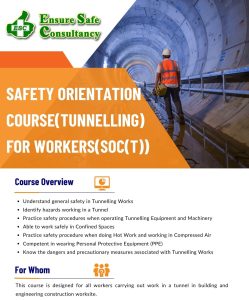Safety Orientation Course (Tunnelling) Overview :
- Understand general safety in Tunnelling Works
- Identify hazards working in a Tunnel
- Practice safety procedures when operating Tunnelling Equipment and Machinery.
- Able to work safely in Confined Spaces
- Practice safety procedure when doing Hot Work and working in Compressed Air
- Competent in wearing Personal Protective Equipment (PPE)
- Know the dangers and precautionary measures associated with Tunnelling Works
Who should attend Safety Orientation Course (Tunnelling)?
The Safety Orientation Course (Tunnelling) is designed for individuals involved in tunnelling projects or working in environments with tunnelling activities. Those who should attend include:
1. Workers in Tunnelling Projects
- Construction workers directly involved in tunnelling activities.
- Employees handling machinery or equipment within tunnelling sites.
2. Supervisors and Foremen
- Site supervisors and foremen responsible for overseeing tunnelling operations.
- Personnel ensuring compliance with safety regulations on-site.
3. Engineers and Technicians
- Civil and mechanical engineers working on tunnelling designs or operations.
- Technicians responsible for maintaining and operating tunnelling equipment.
4. Safety Officers and Coordinators
- Professionals tasked with implementing and monitoring safety protocols in tunnelling environments.
5. Project and Site Managers
- Managers overseeing tunnelling projects who need to understand safety requirements and ensure compliance.
6. Workers in High-Risk Environments
- Personnel working in confined spaces, underground sites, or areas with potential hazards associated with tunnelling.
7. New Hires and Untrained Workers
- Individuals new to tunnelling work or transitioning into roles involving tunnelling activities.
- Workers without prior experience who need foundational safety training.
Key Benefits of Attending:
- Understand safety protocols and risk management for tunnelling projects.
- Learn to operate and navigate safely within tunnelling environments.
- Ensure compliance with workplace safety and health regulations.
Why should attend Safety Orientation Course (Tunnelling)?
The Safety Orientation Course (Tunnelling) is crucial for individuals involved in tunnelling projects to ensure safety, compliance, and efficiency. Here’s why attending this course is important:
1. Ensure Personal and Team Safety
- Learn to identify, assess, and mitigate risks in tunnelling environments.
- Understand protocols for handling emergencies such as collapses, gas leaks, or equipment failures.
2. Comply with Safety Regulations
- Gain knowledge of workplace safety and health regulations specific to tunnelling activities.
- Ensure adherence to legal requirements, avoiding fines and work stoppages.
3. Improve Operational Efficiency
- Learn best practices for working safely in confined spaces, reducing accidents and downtime.
- Understand how to use tunnelling equipment and tools correctly and safely.
4. Mitigate High-Risk Hazards
- Develop skills to manage unique tunnelling risks such as low visibility, noise, and underground hazards.
- Learn to handle explosives, ventilation systems, and heavy machinery with caution.
5. Boost Career Opportunities
- Enhance your qualifications with specialized safety training in tunnelling.
- Gain recognition as a competent worker in high-risk tunnelling environments.
6. Promote a Safety-First Culture
- Foster a culture of safety by leading by example in following safety protocols.
- Encourage teamwork and communication to maintain a safe work environment.
7. Adapt to Advanced Tunnelling Techniques
- Stay updated with modern tunnelling practices and technologies.
- Learn how safety measures evolve with advanced tunnelling systems.
8. Reduce Financial and Operational Losses
- Minimize accidents and incidents that could result in costly delays or equipment damage.
- Improve overall project timelines by maintaining a safe and efficient work environment.
Safety Orientation Course (Tunnelling) ASSUMED SKILLS, KNOWLEDGE & ENTRY REQUIREMENT :
To effectively participate in the Safety Orientation Course (Tunnelling), attendees are expected to meet the following prerequisites and possess relevant skills, knowledge, and attributes:
1. Entry Requirements
Language Proficiency
- Basic Literacy: Ability to read, write, and comprehend instructions in English or the language of instruction.
- Basic Verbal Communication: Capability to communicate effectively with peers and supervisors.
Minimum Education Level
- No Formal Education Required: Basic understanding of workplace environments is sufficient.
- Numeracy Skills: Basic ability to measure distances and interpret simple safety signs and signals.
Work Eligibility
- Legal Working Age: Attendees must meet the legal working age requirements for employment in construction or tunnelling roles.
- Medically Fit: Attendees should be physically and medically fit to work in confined or underground spaces.
2. Assumed Skills
Workplace Awareness
- Familiarity with basic workplace operations, particularly in construction or underground projects.
- Awareness of personal protective equipment (PPE) and its proper use.
Manual Dexterity
- Basic coordination and ability to handle tools and equipment relevant to tunnelling activities.
Observation Skills
- Ability to identify hazards and risks in work environments.
3. Assumed Knowledge
Workplace Safety Basics
- General understanding of workplace hazards and the importance of following safety protocols.
Tools and Equipment
- Familiarity with common tunnelling tools, equipment, and their basic functions (optional but beneficial).
Confined Spaces
- Awareness of the challenges and risks associated with working in confined or underground spaces.
4. Required Attitude
Safety-First Mindset
- Commitment to prioritizing safety for oneself and team members.
Willingness to Learn
- Open-mindedness and eagerness to acquire new skills and knowledge related to tunnelling safety.
Team Collaboration
- Ability to work effectively as part of a team, especially in high-risk environments.
5. Optional Industry Experience
- While prior experience in tunnelling or construction is not mandatory, familiarity with workplace operations can enhance understanding of course content.
COURSE CONTENT :
- Welcome Note/Training Objectives
- Accident Case Studies
- General Safety in Tunnelling Works
- Working Hazards in Tunnelling
- Tunnelling Equipment and Machinery
- Confined Spaces
- Hot Work
- Working in Compressed Air
- Procedures for Safe Work
- Other Safety Precautions
COURSE DURATION :
- 4 hours including 15 minutes of assessment
MEDIUM OF INSTRUCTION :
English.
CLASS SIZE :
Maximum 40
FACILITATOR / LEARNER RATIO :
1:40 for Theory Lesson & Assessment
COURSE ATTENDENCE :
100% Attendance
ASSESSMENT ADVICE :
20 MCQ assessment in 15 minutes and it is a closed book assessment. Assessment papers are to be issued in accordance to the course language registered for only. No mix language assessment is permitted. The passing mark for the written assessment is 60%. Failure to pass the assessments shall render a “Fail” outcome for the learner and he must then re-attempt the course and assessments.
CERTIFICATION :
- Based on the successful completion of the course and assessment, a certificate of achievement endorsed by Ensure safe consultancy Pte. Ltd. will be issued to all trainees.
- E-cert available
VENUE :
3, Soon Lee Street,#02-05 Pioneer Junction, Singapore-627606
COURSE SCHEDULES
Course Features
- Lecture 0
- Quiz 0
- Duration Lifetime access
- Skill level All levels
- Language English
- Students 2
- Certificate Yes
- Assessments Yes








